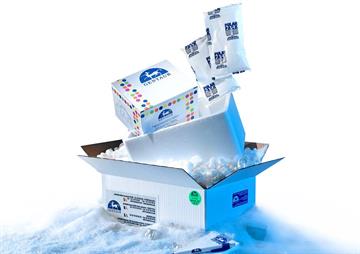SARS-CoV-2 (COVID-19) nucleocapsid antibody

SARS-CoV-2 (COVID-19) nucleocapsid antibody
985.5 EUR
In Stock
quantity
Produktdetaljer
Katalognummer: 944 - BSV-COV-AB-04
Produktkategori: Företag och industri > Vetenskap och laboratorium
BioServUKGentaur
Storlek: 100 ul
Parameters
| Storage and shipping | -20˚C |
|---|
Related Products
9103-002mg
SARS-CoV-2 (COVID-19) Nucleocapsid Antibody
Coronavirus disease 2019 (COVID-19), formerly known as 2019-nCoV acute respiratory disease, is an infectious disease caused by SARS-CoV-2, a virus closely related to the SARS virus. The disease is the cause of the 2019–20 coronavirus outbreak (1). SARS-CoV-2 is the seventh member of the enveloped, positive-stranded RNA viruses that are able to infect humans. The SARS-CoV-2 genome, like other coronaviruses, encodes for multiple structural and nonstructural proteins. The structural proteins include spike protein (S), envelope protein (E), membrane glycoprotein (M), nucleocapsid phosphoprotein (N), and the nonstructural proteins include open reading frame 1ab (ORF1ab), ORF3a, ORF6, ORF7a, ORF8, and ORF10 (2). Nucleocapsid (N) protein is the most abundant protein of coronavirus. It is also one of the major structural proteins and is involved in the transcription and replication of viral RNA, packaging of the encapsidated genome into virions (3), and interference with cell cycle processes of host cells (4). Moreover, in many coronaviruses, including SARS-CoV, the N protein has high immunogenic activity and is abundantly expressed during infection (5). It can be detected in various patient samples including nasopharyngeal aspirate, urine, and fecal. Both S and N proteins may be potential antigens for serodiagnosis of COVID-19, just as many diagnostic methods have been developed for diagnosing SARS based on S and/or N proteins (6).
474.55 €
9103-01mg
SARS-CoV-2 (COVID-19) Nucleocapsid Antibody
Coronavirus disease 2019 (COVID-19), formerly known as 2019-nCoV acute respiratory disease, is an infectious disease caused by SARS-CoV-2, a virus closely related to the SARS virus. The disease is the cause of the 2019–20 coronavirus outbreak (1). SARS-CoV-2 is the seventh member of the enveloped, positive-stranded RNA viruses that are able to infect humans. The SARS-CoV-2 genome, like other coronaviruses, encodes for multiple structural and nonstructural proteins. The structural proteins include spike protein (S), envelope protein (E), membrane glycoprotein (M), nucleocapsid phosphoprotein (N), and the nonstructural proteins include open reading frame 1ab (ORF1ab), ORF3a, ORF6, ORF7a, ORF8, and ORF10 (2). Nucleocapsid (N) protein is the most abundant protein of coronavirus. It is also one of the major structural proteins and is involved in the transcription and replication of viral RNA, packaging of the encapsidated genome into virions (3), and interference with cell cycle processes of host cells (4). Moreover, in many coronaviruses, including SARS-CoV, the N protein has high immunogenic activity and is abundantly expressed during infection (5). It can be detected in various patient samples including nasopharyngeal aspirate, urine, and fecal. Both S and N proteins may be potential antigens for serodiagnosis of COVID-19, just as many diagnostic methods have been developed for diagnosing SARS based on S and/or N proteins (6).
1021.39 €
9099-002mg
SARS-CoV-2 (COVID-19) Nucleocapsid Antibody
Coronavirus disease 2019 (COVID-19), formerly known as 2019-nCoV acute respiratory disease, is an infectious disease caused by SARS-CoV-2, a virus closely related to the SARS virus. The disease is the cause of the 2019–20 coronavirus outbreak (1). SARS-CoV-2 is the seventh member of the enveloped, positive-stranded RNA viruses that are able to infect humans. The SARS-CoV-2 genome, like other coronaviruses, encodes for multiple structural and nonstructural proteins. The structural proteins include spike protein (S), envelope protein (E), membrane glycoprotein (M), nucleocapsid phosphoprotein (N), and the nonstructural proteins include open reading frame 1ab (ORF1ab), ORF3a, ORF6, ORF7a, ORF8, and ORF10 (2). Nucleocapsid (N) protein is the most abundant protein of coronavirus. It is also one of the major structural proteins and is involved in the transcription and replication of viral RNA, packaging of the encapsidated genome into virions (3), and interference with cell cycle processes of host cells (4). Moreover, in many coronaviruses, including SARS-CoV, the N protein has high immunogenic activity and is abundantly expressed during infection (5). It can be detected in various patient samples including nasopharyngeal aspirate, urine, and fecal. Both S and N proteins may be potential antigens for serodiagnosis of COVID-19, just as many diagnostic methods have been developed for diagnosing SARS based on S and/or N proteins (6).
474.55 €
10-113
SARS-CoV-2 (COVID-19) Nucleocapsid Recombinant Protein
SARS-CoV-2 (COVID-19) Nucleocapsid Recombinant Protein
1220.35 €
10-306
SARS-CoV-2 (COVID-19) Nucleocapsid Recombinant Protein
SARS-CoV-2 (COVID-19) Nucleocapsid Recombinant Protein
1078.6 €
10-410
SARS-CoV-2 (COVID-19) Nucleocapsid Recombinant Protein
Coronavirus N protein is required for coronavirus RNA synthesis, and has RNA chaperone activity that may be involved in template switch. Nucleocapsid protein is a most abundant protein of coronavirus. N protein packages the positive strand viral genome RNA into a helical ribonucleocapsid (RNP) and plays a fundamental role during virion assembly through its interactions with the viral genome and membrane protein M. Plays an important role in enhancing the efficiency of subgenomic viral RNA transcription as well as viral replication. Because of the conservation of N protein sequence and its strong immunogenicity, the N protein of coronavirus is chosen as a diagnostic tool.
1106.95 €
Håll dig uppdaterad! Visa tidigare publikationer

By: Author , 2 Comment
Anaplasmos hos hundar och katter – allt du behöver veta
23 August 2025

By: Author , 2 Comment
Solbränna – hur leker man säkert i solen?
16 August 2025

By: Author , 2 Comment
Biologiska läkemedel – Modernitet inom farmaci
1 August 2025

By: Author , 2 Comment
Icke-steroida antiinflammatoriska läkemedel – viktig information om populära läkemedel
22 July 2025








